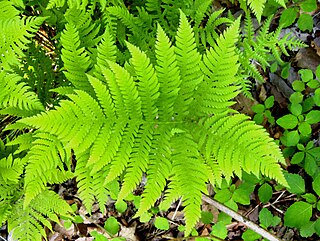
Phegopteris is a genus of ferns in the family Thelypteridaceae, subfamily Phegopteridoideae, in the Pteridophyte Phylogeny Group classification of 2016. They are known collectively as the beech ferns. Species are native to Asia, North America and Europe.
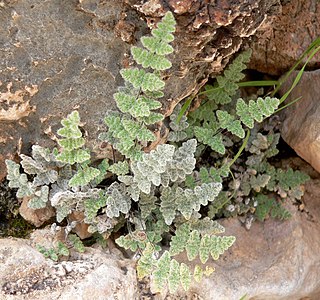
Cheilanthes, commonly known as lip ferns, is a genus of about 180 species of rock-dwelling ferns with a cosmopolitan distribution in warm, dry, rocky regions, often growing in small crevices high up on cliffs. Most are small, sturdy and evergreen. The leaves, often densely covered in trichomes, spring directly from the rootstocks. Many of them are desert ferns, curling up during dry times and reviving with the coming of moisture. At the ends of veins sporangia, or spore-bearing structures, are protected by leaf margins, which curl over them.

Onoclea is a genus of plants in the family Onocleaceae, native to moist habitats in eastern Asia and eastern North America. They are deciduous ferns with sterile fronds arising from creeping rhizomes in spring, dying down at first frost. Fertile fronds appear in late summer. Depending on the authority, the genus contains one to five species.

The Athyriaceae are a family of terrestrial ferns in the order Polypodiales. In the Pteridophyte Phylogeny Group classification of 2016 (PPG I), the family is placed in the suborder Aspleniineae, and includes two genera. Alternatively, it may be treated as the subfamily Athyrioideae of a very broadly defined family Aspleniaceae. The family has with a cosmopolitan distribution.
Alsophila caudata, synonym Cyathea caudata, is a species of tree fern native to the islands of Luzon and Mindanao in the Philippines, where it grows in montane forest. The trunk is erect and up to 4 m tall or more. Fronds are bi- or tripinnate and 1–2 m long. The stipe is warty and covered with dark, narrow, glossy scales. Sori are borne near the midvein of fertile pinnules and are protected by firm, brown indusia. As of April 2022, Plants of the World Online treated it as a synonym of Alsophila speciosa.

Alsophila is a genus of tree ferns in the family Cyatheaceae. It has also been considered to be a section in the subgenus Cyathea of the genus Cyathea.
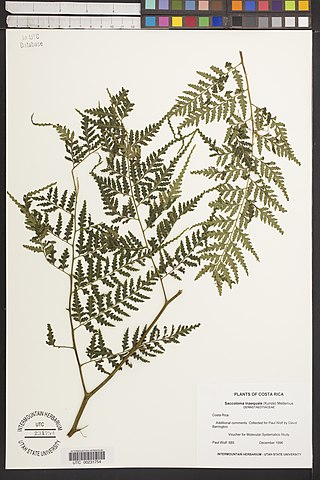
Saccoloma is a fern genus in family Saccolomataceae. It is the only genus in the family in the Pteridophyte Phylogeny Group classification of 2016, but further investigation is needed. It is pantropical and its species are found in wet, shaded forest areas. Saccoloma species are characterized by an omega-shaped (Ω) vascular bundle in the cross-sections of their petioles. The common name soralpouch fern is used for Saccoloma.
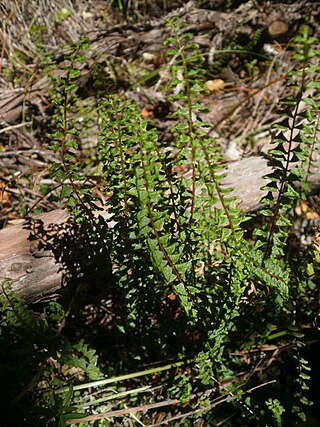
Lindsaeaceae is a pantropical family of ferns in the order Polypodiales. It contains six or seven genera with about 220 known species, some of which also extend into the more temperate regions of eastern Asia, New Zealand, and South America.
Dracoglossum is a small genus of ferns in the family Lomariopsidaceae, according to the Pteridophyte Phylogeny Group classification of 2016 (PPG I). It is native to the Neotropics of the Americas.
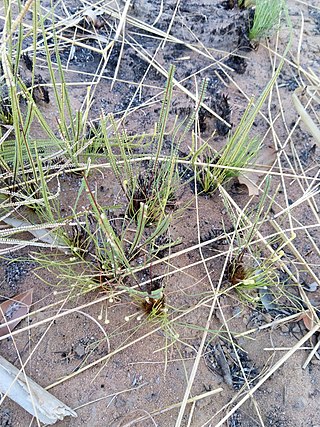
Pteris platyzomopsis, synonym Platyzoma microphyllum, is a species of fern in the family Pteridaceae. When placed in the genus Platyzoma, it was the only species; the genus was sometimes placed in its own family, Platyzomaceae. The species is native to northern Australia, occurring in the Kimberley region of Western Australia, in the Northern Territory and Queensland, and in northern New South Wales, where it is considered endangered. Vernacular names include braid fern.
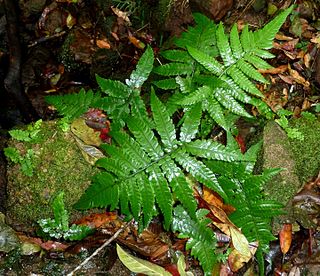
Deparia is a genus of ferns. The Pteridophyte Phylogeny Group classification of 2016 places the genus in the family Athyriaceae, although other sources include it within an expanded Aspleniaceae or Woodsiaceae.

Lindsaea, common name necklace fern, is a genus of around 180 species of fern, 15 of which reach Australia. The name is in honour of surgeon John Lindsay of Jamaica. The genus is sometimes spelt Lindsaya.

Diplaziopsidaceae is a family of ferns in the order Polypodiales. In the Pteridophyte Phylogeny Group classification of 2016 (PPG I), the family is placed in the suborder Aspleniineae, and includes two genera. Alternatively, it may be treated as the subfamily Diplaziopsidoideae of a very broadly defined family Aspleniaceae.
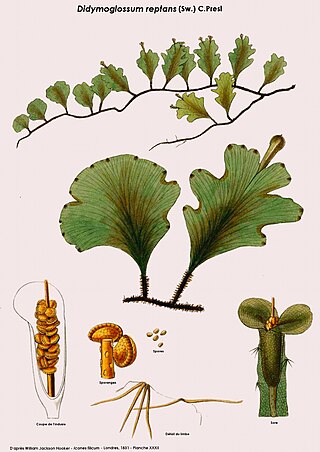
Didymoglossum is a tropical genus of ferns in the family Hymenophyllaceae. It comprises more than 30 epilithic or low-epiphytic species under two subgenera. The genus is accepted in the Pteridophyte Phylogeny Group classification of 2016, but not by some other sources which sink it into a broadly defined Trichomanes.

Odontosoria is a genus of ferns in the family Lindsaeaceae.

Osmolindsaea is a genus of ferns in the family Lindsaeaceae. Most species are found in southeastern Asia, from West Himalaya and Sri Lanka to Japan and New Guinea. Osmolindsaea latisquama and Osmolindsaea leptolepida are found in Madagascar and the adjacent African mainland.

Palhinhaea is a genus of lycophytes in the family Lycopodiaceae. In the Pteridophyte Phylogeny Group classification of 2016, it is placed in the subfamily Lycopodielloideae. Some sources do not recognize the genus, sinking it into Lycopodiella. Palhinhaea species are widespread in the tropics and subtropics.
Oeosporangium pteridioides is a species of fern in the family Pteridaceae. Its native distribution is Macaronesia, around the Mediterranean in Europe, North Africa and Western Asia, and into the Sahara.
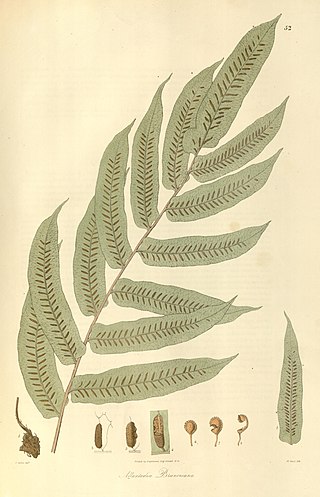
Diplaziopsis is a genus of ferns in the family Diplaziopsidaceae. The genus name means 'like Diplazium'.

Macrothelypteris is a genus of ferns in the family Thelypteridaceae, subfamily Phegopteridoideae, in the Pteridophyte Phylogeny Group classification of 2016. The genus name means 'large Thelypteris'.
















